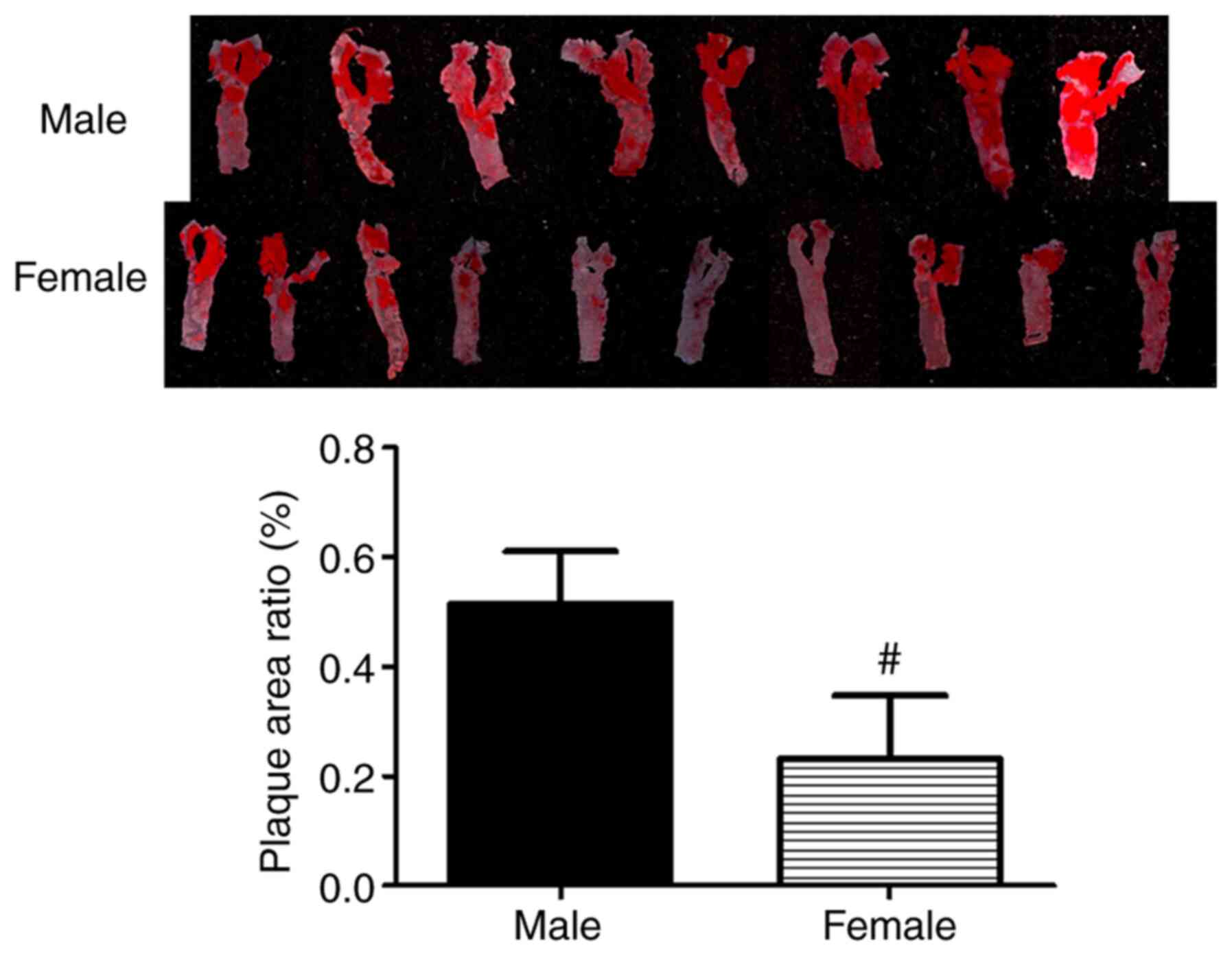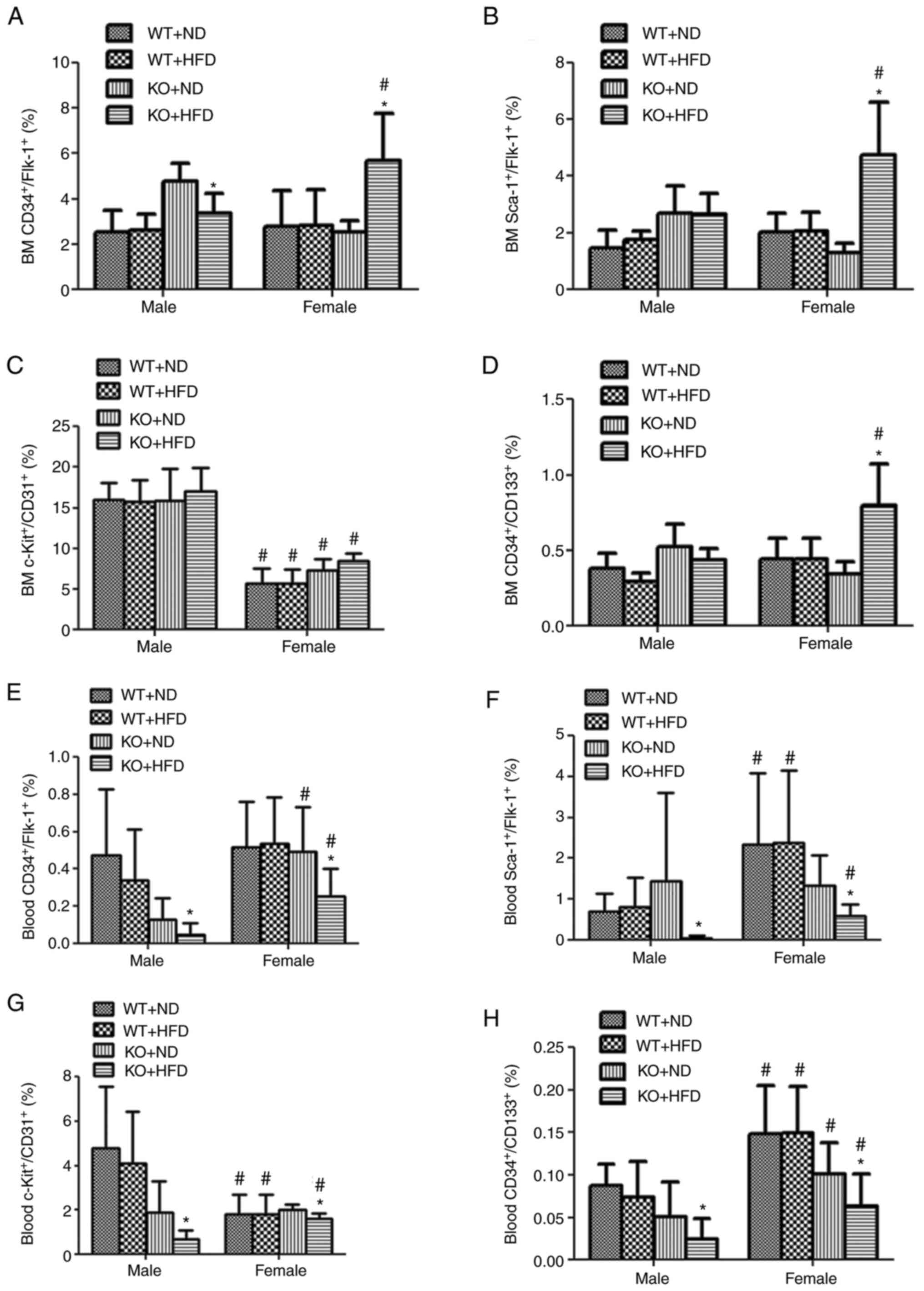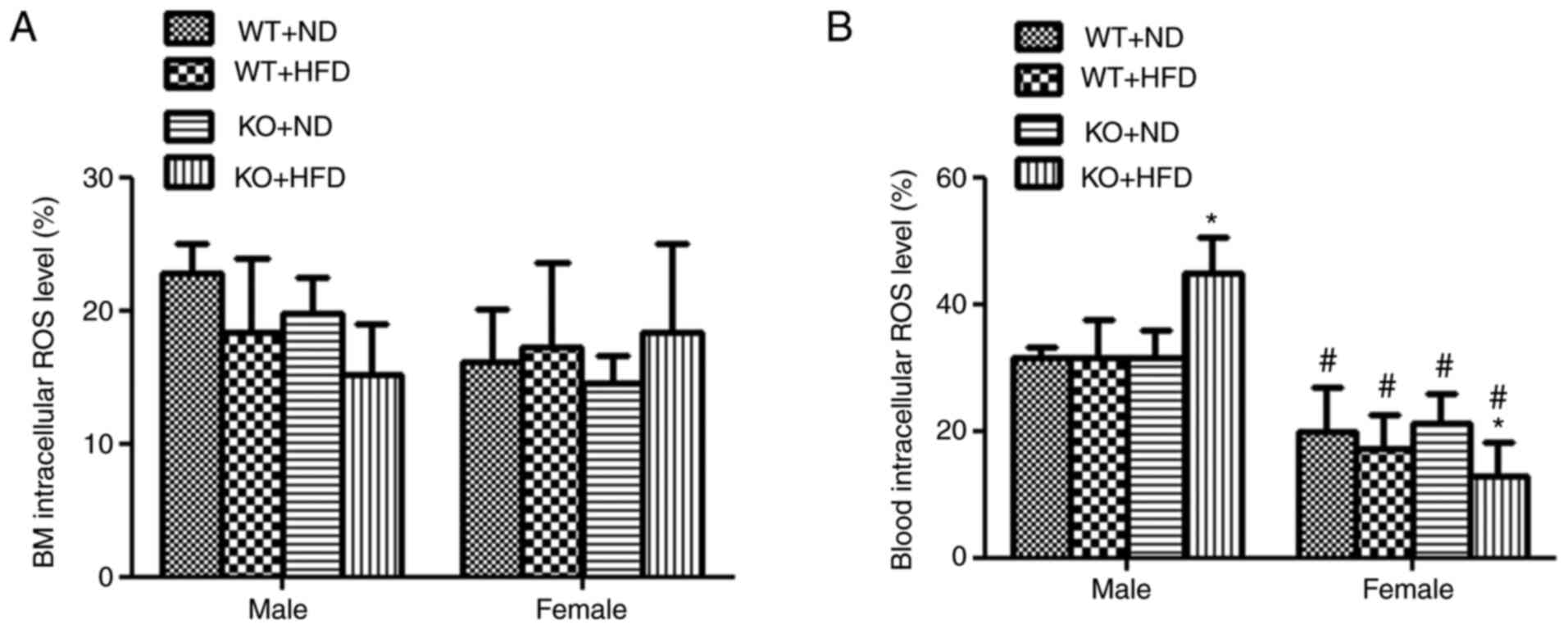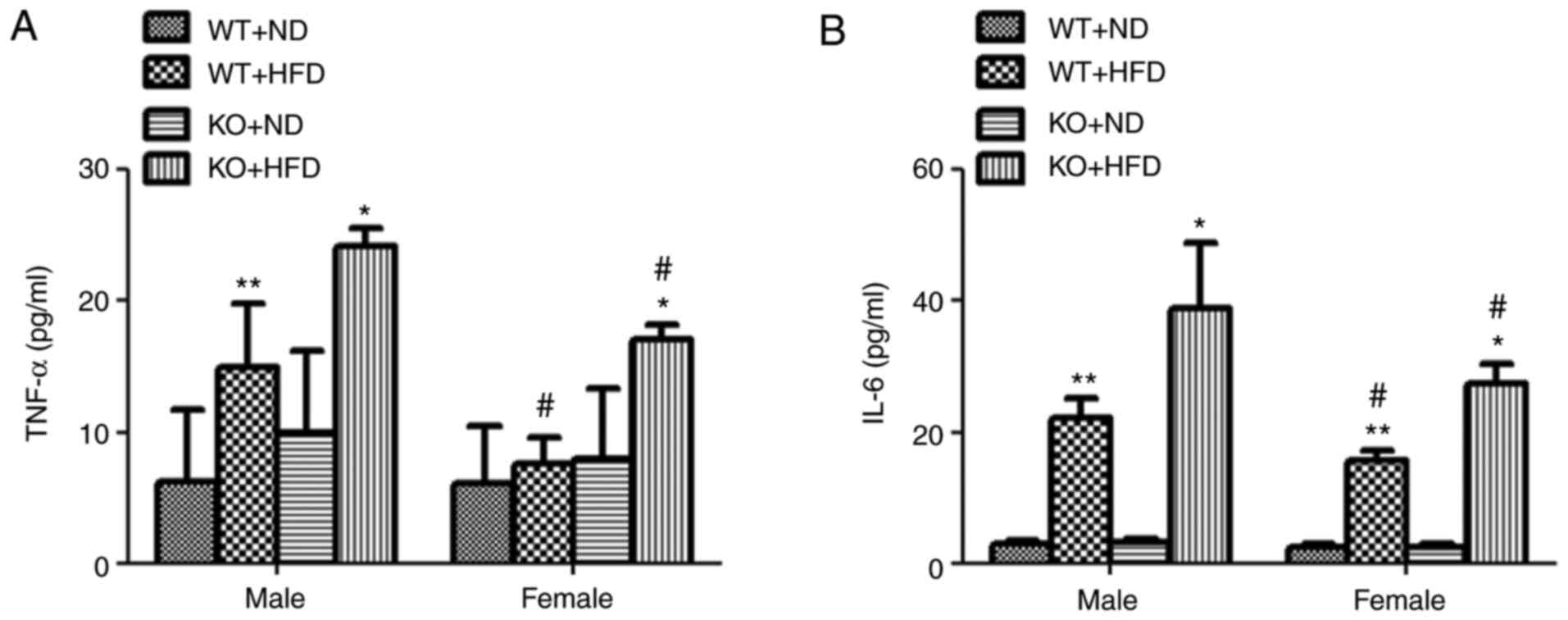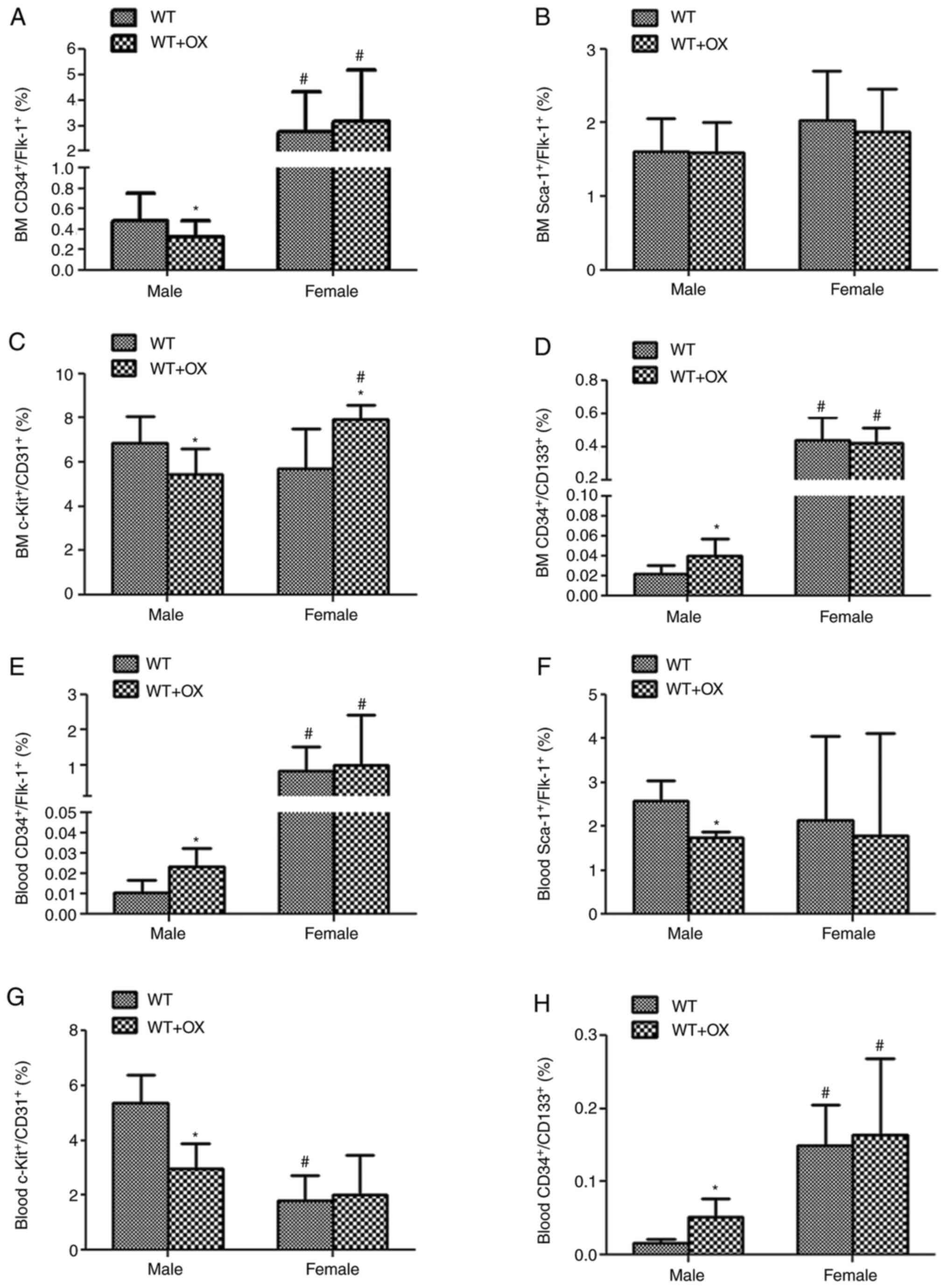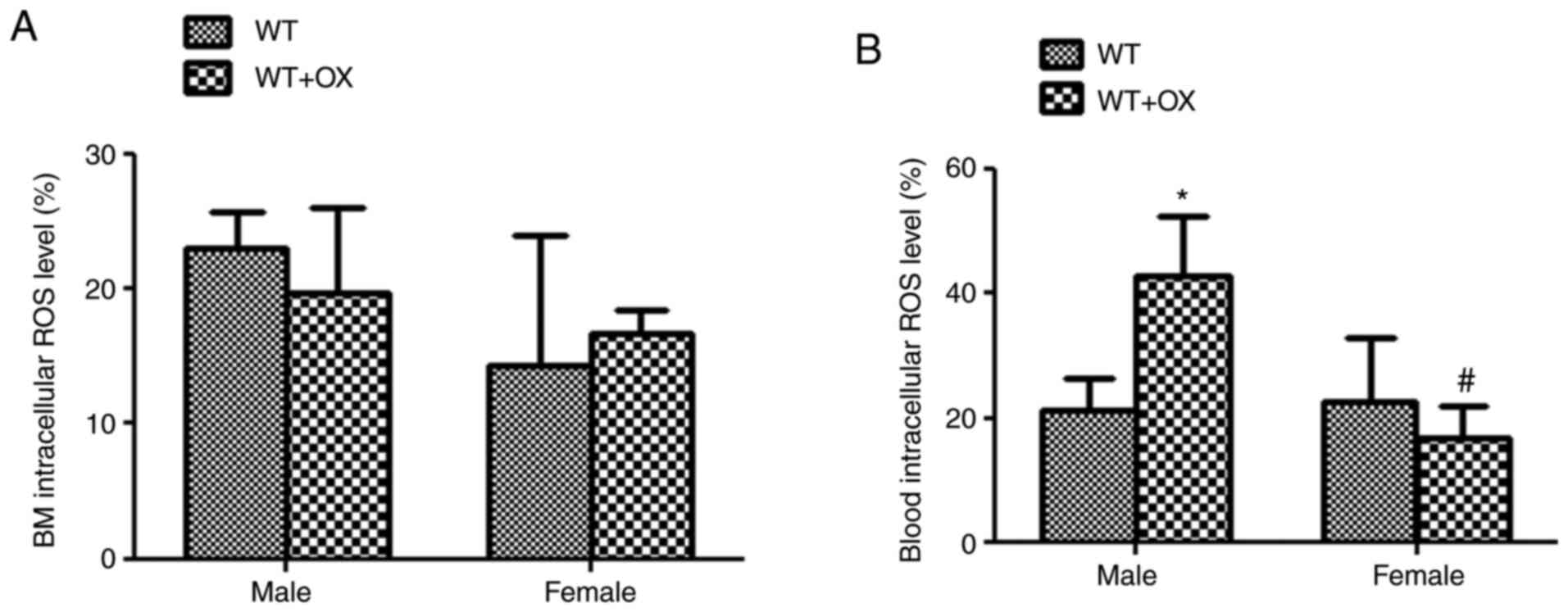|
1
|
Guo Y, Yin F, Fan C and Wang Z: Gender
difference in clinical outcomes of the patients with coronary
artery disease after percutaneous coronary intervention: A
systematic review and meta-analysis. Medicine (Baltimore).
97(e11644)2018.PubMed/NCBI View Article : Google Scholar
|
|
2
|
Shufelt CL, Pacheco C, Tweet MS and Miller
VM: Sex-specific physiology and cardiovascular disease. Adv Exp Med
Biol. 1065:433–454. 2018.PubMed/NCBI View Article : Google Scholar
|
|
3
|
Woodward M: Cardiovascular disease and the
female disadvantage. Int J Environ Res Public Health.
16(1165)2019.PubMed/NCBI View Article : Google Scholar
|
|
4
|
Mudyanadzo TA: Endothelial progenitor
cells and cardiovascular correlates. Cureus.
10(e3342)2018.PubMed/NCBI View Article : Google Scholar
|
|
5
|
Kattoor AJ, Kanuri SH and Mehta JL: Role
of Ox-LDL and LOX-1 in atherogenesis. Curr Med Chem. 26:1693–1700.
2019.PubMed/NCBI View Article : Google Scholar
|
|
6
|
Hartley A, Haskard D and Khamis R:
Oxidized LDL and anti-oxidized LDL antibodies in
atherosclerosis-Novel insights and future directions in diagnosis
and therapy. Trends Cardiovasc Med. 29:22–26. 2019.PubMed/NCBI View Article : Google Scholar
|
|
7
|
Cui Y, Narasimhulu CA, Liu L, Zhang Q, Liu
PZ, Li X, Xiao Y, Zhang J, Hao H, Xie X, et al: N-acetylcysteine
inhibits in vivo oxidation of native low-density lipoprotein. Sci
Rep. 5(16339)2015.PubMed/NCBI View Article : Google Scholar
|
|
8
|
Hamed S, Brenner B and Roguin A: Nitric
oxide: A key factor behind the dysfunctionality of endothelial
progenitor cells in diabetes mellitus type-2. Cardiovasc Res.
91:9–15. 2011.PubMed/NCBI View Article : Google Scholar
|
|
9
|
Thum T and Bauersachs J: Spotlight on
endothelial progenitor cell inhibitors: Short review. Vasc Med. 10
(Suppl 1):S59–S64. 2005.PubMed/NCBI View Article : Google Scholar
|
|
10
|
Zhang Q, Chen L, Si Z, Bu H, Narasimhulu
CA, Song X, Cui MY, Liu H, Lu T, He G, et al: Probucol protects
endothelial progenitor cells against oxidized low-density
lipoprotein via suppression of reactive oxygen species formation in
vivo. Cell Physiol Biochem. 39:89–101. 2016.PubMed/NCBI View Article : Google Scholar
|
|
11
|
Cui Y, Narasimhulu CA, Liu L, Li X, Xiao
Y, Zhang J, Xie X, Hao H, Liu JZ, He G, et al: Oxidized low-density
lipoprotein alters endothelial progenitor cell populations. Front
Biosci (Landmark Ed). 20:975–988. 2015.PubMed/NCBI View
Article : Google Scholar
|
|
12
|
Hermsdorff HH, Barbosa KB, Volp AC, Puchau
B, Bressan J, Zulet MÁ and Martínez JA: Gender-specific
relationships between plasma oxidized low-density lipoprotein
cholesterol, total antioxidant capacity, and central adiposity
indicators. Eur J Prev Cardiol. 21:884–891. 2014.PubMed/NCBI View Article : Google Scholar
|
|
13
|
Lemieux C, Cloutier I and Tanguay JF:
Menstrual cycle influences endothelial progenitor cell regulation:
A link to gender differences in vascular protection? Int J Cardiol.
136:200–210. 2009.PubMed/NCBI View Article : Google Scholar
|
|
14
|
Fadini GP, de Kreutzenberg S, Albiero M,
Coracina A, Pagnin E, Baesso I, Cignarella A, Bolego C, Plebani M,
Nardelli GB, et al: Gender differences in endothelial progenitor
cells and cardiovascular risk profile: The role of female
estrogens. Arterioscler Thromb Vasc Biol. 28:997–1004.
2008.PubMed/NCBI View Article : Google Scholar
|
|
15
|
Forrester SJ, Kikuchi DS, Hernandes MS, Xu
Q and Griendling KK: Reactive oxygen species in metabolic and
inflammatory signaling. Circ Res. 122:877–902. 2018.PubMed/NCBI View Article : Google Scholar
|
|
16
|
Botham KM and Wheeler-Jones CP:
Postprandial lipoproteins and the molecular regulation of vascular
homeostasis. Prog Lipid Res. 52:446–464. 2013.PubMed/NCBI View Article : Google Scholar
|
|
17
|
Barp J, Araujo AS, Fernandes TR, Rigatto
KV, Llesuy S, Belló-Klein A and Singal P: Myocardial antioxidant
and oxidative stress changes due to sex hormones. Braz J Med Biol
Res. 35:1075–1081. 2002.PubMed/NCBI View Article : Google Scholar
|
|
18
|
Ide T, Tsutsui H, Ohashi N, Hayashidani S,
Suematsu N, Tsuchihashi M, Tamai H and Takeshita A: Greater
oxidative stress in healthy young men compared with premenopausal
women. Arterioscl Throm Vas. 22:438–442. 2002.PubMed/NCBI View Article : Google Scholar
|
|
19
|
Matarrese P, Colasanti T, Ascione B,
Margutti P, Franconi F, Alessandri C, Conti F, Riccieri V, Rosano
G, Ortona E and Malorni W: Gender disparity in susceptibility to
oxidative stress and apoptosis induced by autoantibodies specific
to RLIP76 in vascular cells. Antioxid Redox Signal. 15:2825–2836.
2011.PubMed/NCBI View Article : Google Scholar
|
|
20
|
Kander MC, Cui Y and Liu Z: Gender
difference in oxidative stress: A new look at the mechanisms for
cardiovascular diseases. J Cell Mol Med. 21:1024–1032.
2017.PubMed/NCBI View Article : Google Scholar
|
|
21
|
Ji KT, Chai JD, Xing C, Nan JL, Yang PL
and Tang JF: Danshen protects endothelial progenitor cells from
oxidized low-density lipoprotein induced impairment. J Zhejiang
Univ Sci B. 11:618–626. 2010.PubMed/NCBI View Article : Google Scholar
|
|
22
|
Santee SM and OwenSchaub LB: Human tumor
necrosis factor receptor p75/80 (CD120b) gene structure and
promoter characterization. J Biol Chem. 271:21151–21159.
1996.PubMed/NCBI View Article : Google Scholar
|
|
23
|
Ali ES, Mangold C and Peiris AN: Estriol:
Emerging clinical benefits. Menopause. 24:1081–1085.
2017.PubMed/NCBI View Article : Google Scholar
|
|
24
|
Administration CFaD: Food and Drug
Administration regulations, 2021 (In Chinese). http://www.nhc.gov.cn/wjw/s9492/202004/31b4fa14ee174bb1999142525ceba608/files/fd630f2e64cd4060aae826e07d00f562.pdf.
|
|
25
|
Chung BH, Wilkinson T, Geer JC and Segrest
JP: Preparative and quantitative isolation of plasma lipoproteins:
Rapid, single discontinuous density gradient ultracentrifugation in
a vertical rotor. J Lipid Res. 21:284–291. 1980.PubMed/NCBI
|
|
26
|
Chandrakala AN, Sukul D, Selvarajan K,
Sai-Sudhakar C, Sun B and Parthasarathy S: Induction of brain
natriuretic peptide and monocyte chemotactic protein-1 gene
expression by oxidized low-density lipoprotein: Relevance to
ischemic heart failure. Am J Physiol Cell Physiol. 302:C165–C177.
2012.PubMed/NCBI View Article : Google Scholar
|
|
27
|
Li X, Jiang M, Tan T, Narasimhulu CA, Xiao
Y, Hao H, Cui Y, Zhang J, Liu L, Yang C, et al: N-acetylcysteine
prevents oxidized low-density lipoprotein-induced reduction of MG53
and enhances MG53 protective effect on bone marrow stem cells. J
Cell Mol Med. 24:886–898. 2020.PubMed/NCBI View Article : Google Scholar
|
|
28
|
Chang PC, Wu HL, Lin HC, Wang KC and Shi
GY: Human plasminogen kringle 1-5 reduces atherosclerosis and
neointima formation in mice by suppressing the inflammatory
signaling pathway. J Thromb Haemost. 8:194–201. 2010.PubMed/NCBI View Article : Google Scholar
|
|
29
|
Cui Y, Liu L, Xiao Y, Li X, Zhang J, Xie
X, Tian J, Sen CK, He X, Hao H and Liu Z: N-acetylcysteine
differentially regulates the populations of bone marrow and
circulating endothelial progenitor cells in mice with limb
ischemia. Eur J Pharmacol. 881(173233)2020.PubMed/NCBI View Article : Google Scholar
|
|
30
|
Traverse JH, Henry TD, Pepine CJ,
Willerson JT, Zhao DX, Ellis SG, Forder JR, Anderson RD,
Hatzopoulos AK, Penn MS, et al: Effect of the use and timing of
bone marrow mononuclear cell delivery on left ventricular function
after acute myocardial infarction: The TIME randomized trial. JAMA.
308:2380–2389. 2012.PubMed/NCBI View Article : Google Scholar
|
|
31
|
Perin EC, Willerson JT, Pepine CJ, Henry
TD, Ellis SG, Zhao DX, Silva GV, Lai D, Thomas JD, Kronenberg MW,
et al: Effect of transendocardial delivery of autologous bone
marrow mononuclear cells on functional capacity, left ventricular
function, and perfusion in chronic heart failure: The FOCUS-CCTRN
Trial. JAMA. 307:1717–1726. 2012.PubMed/NCBI View Article : Google Scholar
|
|
32
|
Zhao Y, Yu P, Wu R, Ge Y, Wu J, Zhu J and
Jia R: Renal cell carcinoma-adjacent tissues enhance mobilization
and recruitment of endothelial progenitor cells to promote the
invasion of the neoplasm. Biomed Pharmacother. 67:643–649.
2013.PubMed/NCBI View Article : Google Scholar
|
|
33
|
Yang JJ, Ii M, Kamei N, Alev C, Kwon SM,
Kawamoto A, Akimaru H, Masuda H, Sawa Y and Asahara T: CD34+ Cells
represent highly functional endothelial progenitor cells in murine
bone marrow. PLoS One. 6(e20219)2011.PubMed/NCBI View Article : Google Scholar
|
|
34
|
Liu LP, Kakiuchi-Kiyota S, Arnold LL,
Johansson SL, Wert D and Cohen SM: Pathogenesis of human
hemangiosarcomas and hemangiomas. Hum Pathol. 44:2302–2311.
2013.PubMed/NCBI View Article : Google Scholar
|
|
35
|
Feng YM, Schouteden S, Geenens R, Van
Duppen V, Herijgers P, Holvoet P, Van Veldhoven PP and Verfaillie
CM: Hematopoietic Stem/Progenitor cell proliferation and
differentiation is differentially regulated by high-density and
low-density lipoproteins in mice. PLoS One.
7(e47286)2012.PubMed/NCBI View Article : Google Scholar
|
|
36
|
Westerweel PE, Teraa M, Rafii S, Jaspers
JE, White IA, Hooper AT, Doevendans PA and Verhaar MC: Impaired
endothelial progenitor cell mobilization and dysfunctional bone
marrow stroma in diabetes mellitus. PLoS One.
8(e60357)2013.PubMed/NCBI View Article : Google Scholar
|
|
37
|
Houlihan DD, Mabuchi Y, Morikawa S, Niibe
K, Araki D, Suzuki S, Okano H and Matsuzaki Y: Isolation of mouse
mesenchymal stem cells on the basis of expression of Sca-1 and
PDGFR-α. Nat Protoc. 7:2103–2111. 2012.PubMed/NCBI View Article : Google Scholar
|
|
38
|
Bilski P, Belanger AG and Chignell CF:
Photosensitized oxidation of 2',7'-dichlorofluorescin: Singlet
oxygen does not contribute to the formation of fluorescent
oxidation product 2',7'-dichlorofluorescein. Free Radical Bio Med.
33:938–946. 2002.PubMed/NCBI View Article : Google Scholar
|
|
39
|
Robinson JP, Bruner LH, Bassoe CF, Hudson
JL, Ward PA and Phan SH: Measurement of intracellular fluorescence
of human-monocytes relative to oxidative-metabolism. J Leukocyte
Biol. 43:304–310. 1988.PubMed/NCBI View Article : Google Scholar
|
|
40
|
Cai JJ, Wen J, Jiang WH, Lin J, Hong Y and
Zhu YS: Androgen actions on endothelium functions and
cardiovascular diseases. J Geriatr Cardiol. 13:183–196.
2016.PubMed/NCBI View Article : Google Scholar
|
|
41
|
Hoetzer GL, MacEneaney OJ, Irmiger HM,
Keith R, Van Guilder GP, Stauffer BL and DeSouza CA: Gender
differences in circulating endothelial progenitor cell
colony-forming capacity and migratory activity in middle-aged
adults. Am J Cardiol. 99:46–48. 2007.PubMed/NCBI View Article : Google Scholar
|
|
42
|
Liu H, Liu K and Bodenner DL: Estrogen
receptor inhibits interleukin-6 gene expression by disruption of
nuclear factor kappaB transactivation. Cytokine. 31:251–257.
2005.PubMed/NCBI View Article : Google Scholar
|
|
43
|
Hamada H, Kim MK, Iwakura A, Ii M, Thorne
T, Qin G, Asai J, Tsutsumi Y, Sekiguchi H, Silver M, et al:
Estrogen receptors alpha and beta mediate contribution of bone
marrow-derived endothelial progenitor cells to functional recovery
after myocardial infarction. Circulation. 114:2261–2270.
2006.PubMed/NCBI View Article : Google Scholar
|
|
44
|
Shao R, Egecioglu E, Weijdegård B,
Kopchick JJ, Fernandez-Rodriguez J, Andersson N and Billig H:
Dynamic regulation of estrogen receptor-alpha isoform expression in
the mouse fallopian tube: Mechanistic insight into
estrogen-dependent production and secretion of insulin-like growth
factors. Am J Physiol Endocrinol Metab. 293:E1430–E1442.
2007.PubMed/NCBI View Article : Google Scholar
|
|
45
|
Matthews J, Almlof T, Kietz S, Leers J and
Gustafsson JA: Estrogen receptor-alpha regulates SOCS-3 expression
in human breast cancer cells. Biochem Biophys Res Commun.
335:168–174. 2005.PubMed/NCBI View Article : Google Scholar
|
|
46
|
Roggia C, Gao YH, Cenci S, Weitzmann MN,
Toraldo G, Isaia G and Pacifici R: Up-regulation of TNF-producing T
cells in the bone marrow: A key mechanism by which estrogen
deficiency induces bone loss in vivo. Proc Natl Acad Sci USA.
98:13960–13965. 2001.PubMed/NCBI View Article : Google Scholar
|
|
47
|
Fadini GP, Albiero M, Cignarella A, Bolego
C, Pinna C, Boscaro E, Pagnin E, De Toni R, de Kreutzenberg S,
Agostini C and Avogaro A: Effects of androgens on endothelial
progenitor cells in vitro and in vivo. Clin Sci (Lond).
117:355–364. 2009.PubMed/NCBI View Article : Google Scholar
|
|
48
|
Kim SW, Hwang JH, Cheon JM, Park NS, Park
SE, Park SJ, Yun HJ, Kim S and Jo DY: Direct and indirect effects
of androgens on survival of hematopoietic progenitor cells in
vitro. J Korean Med Sci. 20:409–416. 2005.PubMed/NCBI View Article : Google Scholar
|
|
49
|
Garolla A, D'Inca R, Checchin D, Biagioli
A, De Toni L, Nicoletti V, Scarpa M, Bolzonello E, Sturniolo GC and
Foresta C: Reduced endothelial progenitor cell number and function
in inflammatory bowel disease: A possible link to the pathogenesis.
Am J Gastroenterol. 104:2500–2507. 2009.PubMed/NCBI View Article : Google Scholar
|
|
50
|
Chen Y, Ji LL, Liu TY and Wang ZT:
Evaluation of gender-related differences in various oxidative
stress enzymes in mice. Chinese J Physiol. 54:385–390.
2011.PubMed/NCBI View Article : Google Scholar
|
|
51
|
Vina J, Gambini J, Lopez-Grueso R,
Abdelaziz KM, Jove M and Borras C: Females live longer than males:
Role of oxidative stress. Curr Pharm Design. 17:3959–3965.
2011.PubMed/NCBI View Article : Google Scholar
|
|
52
|
Miller AA, Drummond GR, Mast AE, Schmidt
HH and Sobey CG: Effect of gender on NADPH-oxidase activity,
expression, and function in the cerebral circulation: Role of
estrogen. Stroke. 38:2142–2149. 2007.PubMed/NCBI View Article : Google Scholar
|
|
53
|
Leal V, Ribeiro CF, Oliveiros B, Antonio N
and Silva S: Intrinsic vascular repair by endothelial progenitor
cells in acute coronary syndromes: An Update overview. Stem Cell
Rev. 15:35–47. 2019.PubMed/NCBI View Article : Google Scholar
|
|
54
|
Zaccone V, Flore R, Santoro L, De Matteis
G, Giupponi B, Li Puma DD and Santoliquido A: Focus on biological
identity of endothelial progenitors cells. Eur Rev Med Pharmacol
Sci. 19:4047–4063. 2015.PubMed/NCBI
|
|
55
|
Kawakami Y, Matsumoto T, Mifune Y, Fukui
T, Patel KG, Walker GN, Kurosaka M and Kuroda R: Therapeutic
potential of endothelial progenitor cells in the field of
orthopaedics. Curr Stem Cell Res Ther. 12:3–13. 2017.PubMed/NCBI View Article : Google Scholar
|
|
56
|
Testa U, Saulle E, Castelli G and Pelosi
E: Endothelial progenitor cells in hematologic malignancies. Stem
Cell Investig. 3(26)2016.PubMed/NCBI View Article : Google Scholar
|
|
57
|
Sandhu K, Mamas M and Butler R:
Endothelial progenitor cells: Exploring the pleiotropic effects of
statins. World J Cardiol. 9:1–13. 2017.PubMed/NCBI View Article : Google Scholar
|
|
58
|
Kawamoto A and Asahara T: Role of
progenitor endothelial cells in cardiovascular disease and upcoming
therapies. Catheter Cardiovasc Interv. 70:477–484. 2007.PubMed/NCBI View Article : Google Scholar
|
|
59
|
Torsney E and Xu Q: Resident vascular
progenitor cells. J Mol Cell Cardiol. 50:304–311. 2011.PubMed/NCBI View Article : Google Scholar
|
|
60
|
Heissig B, Werb Z, Rafii S and Hattori K:
Role of c-kit/Kit ligand signaling in regulating vasculogenesis.
Thromb Haemost. 90:570–576. 2003.PubMed/NCBI View Article : Google Scholar
|
|
61
|
Beneventi F, De Maggio I, Cavagnoli C,
Bellingeri C, Ruspini B, Riceputi G, Viarengo G, Ramoni V and
Spinillo A: Endothelial progenitor cell CD34+ and
CD133+ concentrations and soluble HLA-G concentrations
during pregnancy and in cord blood in undifferentiated connective
tissue diseases compared to controls. Reprod Sci. 28:1382–1389.
2021.PubMed/NCBI View Article : Google Scholar
|



